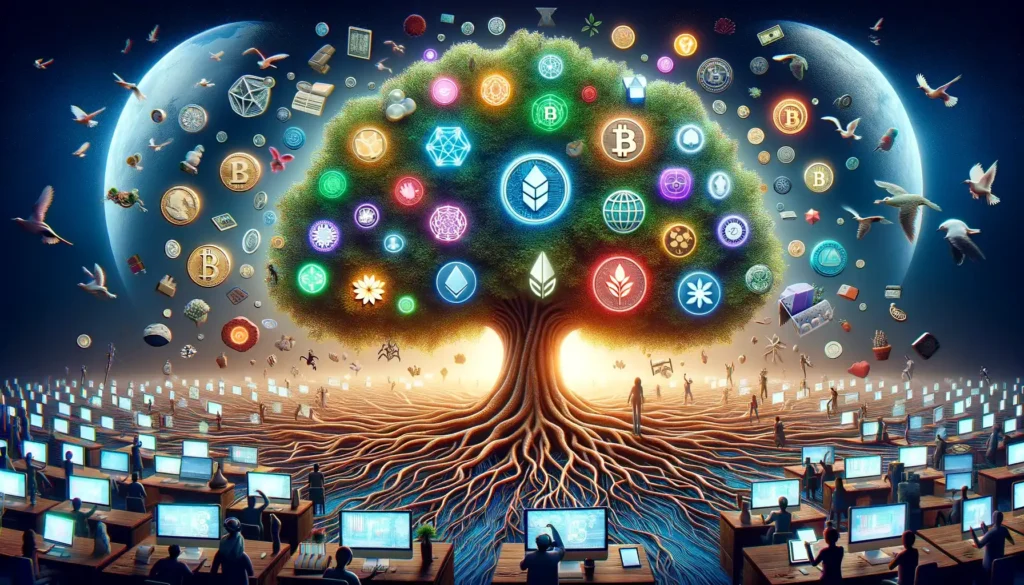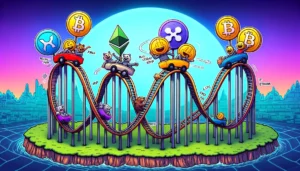The Decentralized Finance (DeFi) sector stands on the brink of a pivotal year, with the future of DeFi looking more dynamic and promising than ever. As we gaze into the crystal ball of the latest DeFi trends, we see a tapestry of emerging DeFi trends that could redefine the very fabric of the industry. With DeFi market trends indicating a shift towards a seamless incorporation of decentralized and traditional financial systems, the DeFi industry forecast for 2024 hints at a cross-pollination of services that will revolutionize how we interact with finance. Leading the charge are DeFi predictions that point towards advanced solutions in decentralized insurance and asset management, dovetailing neatly into an ecosystem poised for comprehensive financial solutions.
Amidst this transformative landscape, a new regard for privacy and a nod towards ecological responsibility emerge as critical themes. Enhanced security measures aimed at fortifying privacy in crypto transactions are gaining momentum, paralleling the burgeoning pursuit of environmental sustainability in the crypto space. As eco-friendly and energy-efficient initiatives take root, we witness an industry aligning itself with a broader global consciousness. The convergence of these trends signals not just the maturation of the DeFi space but an evolution poised to set new benchmarks for financial innovation.
Key Takeaways
- DeFi platforms are expanding to include novel services like decentralized insurance and asset management, signaling the future of DeFi.
- 2024 is heralding a tighter weave between DeFi and mainstream finance, promising an uptick in DeFi’s adoption and integration.
- Addressing privacy concerns in cryptocurrency transactions is a pivotal trend, highlighting the industry’s shift towards privacy-centric solutions.
- The DeFi industry is making strides towards environmental sustainability with a spike in green initiatives.
- With its finger on the pulse of market demands, DeFi is gearing up for an era of unprecedented financial solutions and services.
Exploring the Evolution of DeFi Platforms and Services
As we near the pivotal year of 2024, the realm of decentralized finance trends leads us down an exciting path of both transformation and integration. The continuous DeFi platform advancements indicate a future where finance is no longer compartmentalized but seamlessly interconnected. In this environment, the boundaries between decentralized models and traditional financial ecosystems not only blur but also create synergies benefiting a diverse user base.
Advancement in Decentralized Insurance and Asset Management
The proliferation of DeFi has paved the way for more sophisticated financial instruments to emerge. Innovations in decentralized insurance and asset management are prime examples of the evolution within the DeFi services sector. These advancements serve as a beacon for the types of integrated solutions that aim to streamline and safeguard the financial activities of businesses and individuals alike.
Here’s a snapshot of the areas where decentralized finance is innovating and what they promise for the future:
| DeFi Service | Description | Impact |
|---|---|---|
| Decentralized Insurance | Innovative coverage options without traditional intermediaries. | Improved risk management and lower costs for consumers. |
| Decentralized Asset Management | Asset diversification and management through decentralized protocols. | Greater autonomy and control for investors. |
| Smart Contract-Based Services | Automated agreement executions specializing in insurance and asset handling. | Increased efficiency and reduced chances of disputes. |
Integration of DeFi with Traditional Financial Systems
The integration of DeFi with conventional banking and finance systems not only represents a leap forward in accessibility but also stands to bolster consumer trust. Merging decentralized and traditional systems harnesses the transparency and security of blockchain while offering the robustness of tried-and-true financial products. This symbiotic relation extends the outreach of DeFi, making it a more integral part of the global financial narrative.
As these DeFi services evolve, they are expected to adhere to regulatory standards and user expectations, giving way to a new realm of fiscal operations that is resilient, agile, and inclusive. Observing the current trajectory, one can envisage a future where DeFi does not compete with traditional finance, but rather complements it, filling gaps and offering efficiencies previously unimagined.
DeFi Trends and Predictions
In the dynamic world of decentralized finance trends, the upcoming year of 2024 is expected to be a turning point for the DeFi industry. With an emphasis on creating a more secure, scalable, and user-friendly platform, we are likely to witness the top DeFi predictions come to fruition, setting the stage for an era of unprecedented financial possibilities. A closer look at the DeFi market trends reveals that the maturation of DeFi will be a cornerstone of the changes to come.
One of the major drivers for this evolution is the advancement in infrastructure that supports enhanced interoperability among various DeFi platforms. This inclusiveness is not only set to refine the user experience but also to extend the capabilities and accessibility of DeFi, challenging traditional financial institutions to innovate or be left behind.
The improved regulatory framework expected in the year ahead signifies a fresh wave of clarity. This guidance may likely result in an upsurge in global adoption rates. Let’s explore the potential growth areas and innovations forecasted to mark the DeFi predictions for 2024.

According to industry analysts, the following aspects of DeFi will be key focal points:
- User Experience Enhancements: Simplifying and improving the overall DeFi user interface to ensure a smooth, intuitive experience.
- Security and Scalability: Addressing current challenges by integrating cutting-edge technology to protect user assets and empower the DeFi infrastructure to manage increased transaction loads efficiently.
- Regulatory Clarity: Establishing clearer regulations for DeFi and cryptocurrencies to facilitate wider adoption and incorporation into mainstream finance.
- Traditional Financial Institutions: Forging partnerships and integrating DeFi services, thus enabling a seamless coexistence of decentralized and traditional finance systems.
| Area of DeFi Maturation | Expected Advancements |
|---|---|
| Interoperability | Fostering a seamless ecosystem where various DeFi platforms can interact, increasing the fluidity of asset transfer. |
| Regulatory Developments | Enhanced regulatory engagement, providing users with clear guidelines and greater confidence in DeFi services. |
| Platform Security | Bolstering defenses against cyber threats, ensuring a secure environment for users to engage with DeFi offerings. |
| User-Friendly Interfaces | Revamping interfaces to offer an intuitive, frictionless user experience for all levels of cryptocurrency enthusiasts. |
The horizons of DeFi are expanding, and as we step into 2024, stakeholders across the board—from investors to developers—are preparing for a landscape that is not only more robust and secure but also aligned with a shifting global financial ecosystem. Such decentralized finance trends suggest an integrative approach, where conventional financial models might meld with innovative DeFi solutions to create a financially inclusive world, without compromising on security, functionality, or scalability.
Embracing New Dimensions of NFT Utility and Asset Tokenization
As we advance into 2024, the narrative of Non-Fungible Tokens (NFTs) continues to evolve, embracing roles that propel them beyond the realm of digital art. These digital assets are establishing themselves as key players in the tokenization of both tangible and virtual assets, expanding their utility in unprecedented ways. This expansion reflects the multifaceted nature of NFTs, as they become instrumental in a variety of sectors, including real estate and gaming, offering new levels of efficiency and innovation in asset tokenization.
Expansion of NFTs into Real Estate and Gaming Sectors
The integration of NFTs in real estate is transforming property transactions, enabling a more streamlined and transparent process of buying, selling, and leasing properties. Asset tokenization with NFTs allows for a fractional ownership structure wherein investors can hold a stake in physical properties, opening up investment opportunities that were previously inaccessible to many. Simultaneously, NFTs in gaming are reconstructing the industry’s economic model, allowing players to truly own and trade in-game items as tangible assets, enhancing both player engagement and game developers’ monetization strategies.
Innovative Uses of NFTs in Intellectual Property

The leap of NFTs into the domain of intellectual property is yet another frontier where their potential is rapidly being recognized. In intellectual property, NFTs offer a unique means of asserting ownership and transacting usage rights. This facilitates creators and rights holders to monetize their work more effectively, safeguard their creations against infringement, and manage their assets in a decentralized and secure environment. Such innovative uses of NFTs are indicative of an ongoing paradigm shift in how we handle and value creative work and proprietary content.
As these developments unfold, it becomes clear that the embrace of NFT utility expansion is more than a fleeting trend; it’s a transformative process that’s reshaping vast sectors of our economy. In the coming years, as the adoption of NFTs advances, we may witness an even broader spectrum of utility that has the power to significantly impact the fabric of various industries, further cementing the role of NFTs in the digital age.
Asset tokenization with NFTs is not just about transforming asset management; it’s about reinventing our concept of ownership and investment in the digital era.
The Rise of Interoperability in Decentralized Financial Systems
In the unfolding scenario of 2024, a key storyline within the crypto world is the ascent of interoperability in crypto. Interoperability has become the heartbeat of decentralized financial systems, showcasing an industry keen on achieving a level of synergy comparable with the seamless fluidity of the internet itself. Projects are no longer seeing borders within the blockchain universe; instead, they are building bridges. The impact of such a trend extends beyond mere convenience, symbolizing a significant leap in how we conceive and utilize blockchain networks.
This leap is marked by a concerted focus on cross-chain collaboration, a move towards creating an interconnected ecosystem where barriers between different blockchain networks are diminishing, if not vanishing. The possibility of a user-friendly, interconnected blockchain networks wherein assets and information can flow without hindrance is not just appealing; it’s revolutionary. This development underlines the industry’s commitment to forging a path for crypto ecosystem interoperability, epitomizing a profound transformation in the capabilities and potential applications of blockchain technologies.
As we look to the remainder of 2024 and beyond, the signs are clear: interoperability isn’t just a feature—it’s the future—promising a comprehensive crypto landscape that’s more integrated, efficient, and most importantly, accessible to all. Users are at the cusp of experiencing a decentralized finance that’s not defined by the limits of a single platform or network but by the vast potential of an interconnected, harmonious digital economy.
Frequently Asked Questions
| Question | Answer |
|---|---|
| What are the trends for DeFi 2024? | In 2024, DeFi trends include the integration of traditional financial products, the monetization of blockchain gaming, advancements in cross-chain technology, the growth of DEXs and AMMs, and the increasing importance of governance tokens. |
| What is trending in DeFi? | Current trends in DeFi involve the integration of real-world assets, the rise of stablecoins, layer-2 scaling solutions, focus on security and compliance, and the growth of decentralized autonomous organizations (DAOs). |
| Is there any future in DeFi? | Yes, DeFi is expected to continue evolving with innovations in financial products, blockchain technology, and regulatory frameworks, indicating a robust future. |
| Will DeFi make a comeback? | DeFi is poised for growth, adapting to challenges and evolving with new technologies and regulatory environments. While it’s not a comeback per se, as it never left, DeFi is likely to become more integral to the financial landscape. |
| How does blockchain gaming impact DeFi? | Blockchain gaming introduces new forms of monetization and asset transferability within games, which could significantly influence DeFi by integrating in-game currencies and assets into the DeFi ecosystem. |
| How does cross-chain technology help DeFi? | Cross-chain technology addresses scalability and high transaction costs in DeFi, allowing for smoother interoperability and more efficient transactions across different blockchain networks. |
| What role do governance tokens play in DeFi? | Governance tokens give holders voting rights in the management of DeFi protocols, influencing decisions and policies. They’re integral to the decentralized and autonomous nature of these platforms, affecting their growth and evolution. |
| How are traditional financial products used in DeFi? | Traditional financial products, like derivatives and tranche lending, are being adapted into DeFi, increasing the sector’s complexity and utility by offering more sophisticated financial instruments. |




